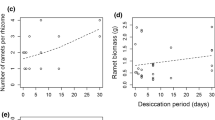Abstract
Several types of tussock formed byCarex thunbergii var.appendiculata were compared with respect to the growth pattern of their rhizomes at various developmental stages at Benten Marsh in Yufutsu Mire, Hokkaido, Japan. The rhizomes were classified into three types based on their function: 1, very short rhizomes; 2, intermediate-length rhizomes which grow upwards to raise the shoot base; 3, long rhizomes which grow horizontaly to spread the plant. The extent of development of the tussock and the total length of rhizomes per shoot was inversely related with the number of Type 3 rhizomes, and positively related with Types 1 and 2 rhizomes. The tussock was made of dead roots, dead rhizomes and much litter, which provided a substitute for soil for the rhizomes and absorbing roots. The growth conditions of theCarex changed from aerobic and eutrophic to anoxic and oligotrophic with tussock development. It is concluded that the tussock is adaptive to anoxic conditions.
Similar content being viewed by others
References
Dawkins, C. J. (1939) Tussock formation bySchoenus nigricans: The action of fire and water erosion. J. Ecol.27: 78–88.
Grime, J. P. (1979) Plant strategies and vegetation processes. 222 pp. John Wiley, Chichester.
Jeglum, J. K. (1971) Plant indicator of pH and water level in peatlands at Candle Lake, Saskatchewan. Can. J. Bot.49: 1661–1676.
Morisita, M. (1959) Measuring of the dispersion of individuals and analysis of the distribution patterns. Mem. Fac. Sci., Kyushu Univ., Ser. E. (Biol.)2: 215–235.
Tachibana, H. &Ito, K. (1981) Phytosociological studies of Yufutsu Mire in the central part of Hokkaido, Japan. Env. Sci. Hokkaido University4: 13–79 (In Japanese with English summary).
Tanaka, M. (1959) Phytosociological studies on the moors in eastern Hokkaido IV. Structural analyses on the tonsure-like root system in theCarex augustinowiczii community. J. Hokkaido Gakugei University10: 126–131 (In Japanese with English summary).
Tanaka, M. (1962) Ecological studies of some fen-tussocks in the Kushiro Moor, Hokkaido. J. Hokkaido Gakugei University13: 52–61.
Tatewaki, M. &Ishizuka, K. (1969) Moor vegetation of Senjogahara, Nikko, Central Honshu, Japan. The Sapporo Bull. of the Botanic Garden, Hokkaido University2: 1–72 (In Japanese).
Yabe, K. (1985) Distribution and formation of tussocks in Mobara-Yatsumi marsh. Jpn. J. Ecol.35: 183–191.
Yamada, S. (1959) Study on Yachibozu and Tokachibozu—studies on pattern ground in Hokkaido 1. J. Sci. Soil Manure, Japan30: 49–52 (In Japanese).
Yano, N. (1981) The subterranean structure ofPhragmites communis communities. Hikobia Suppl.1: 371–380 (In Japanese with English summary).
Yapp, R. H., Johns, D. &Jones, O. T. (1917) The salt marshes of the Dovey Estuary. J. Ecol.5: 65–103.
Author information
Authors and Affiliations
About this article
Cite this article
Nishikawa, Y. Role of rhizomes in tussock formation byCarex thunbergii var.Appendiculata . Ecol. Res. 5, 261–269 (1990). https://doi.org/10.1007/BF02346996
Accepted:
Issue Date:
DOI: https://doi.org/10.1007/BF02346996




